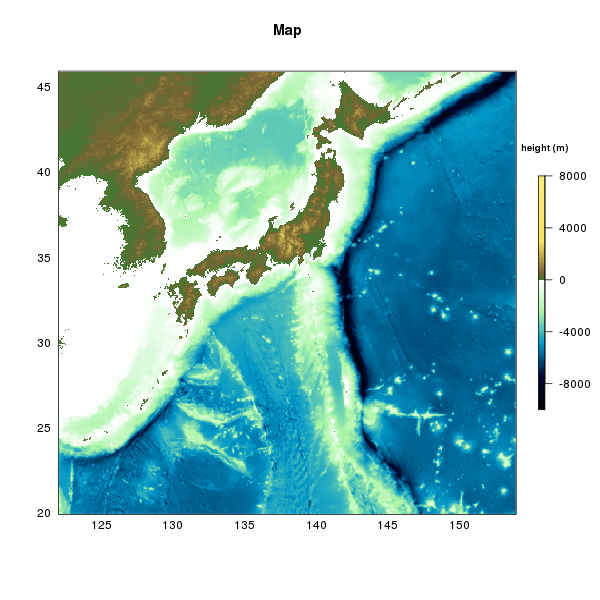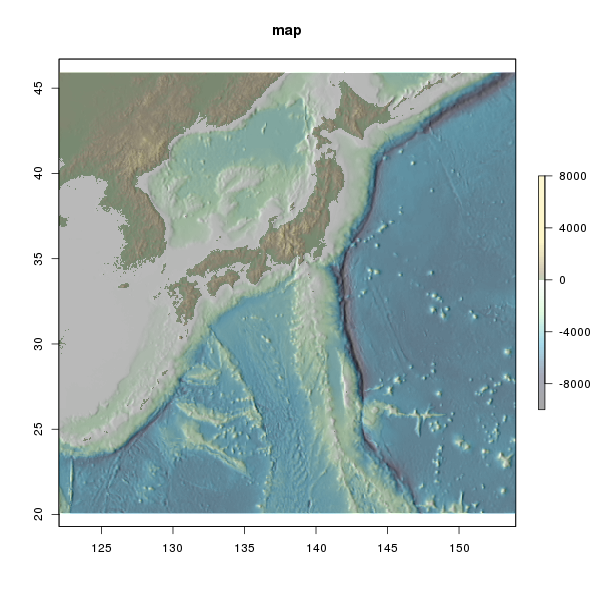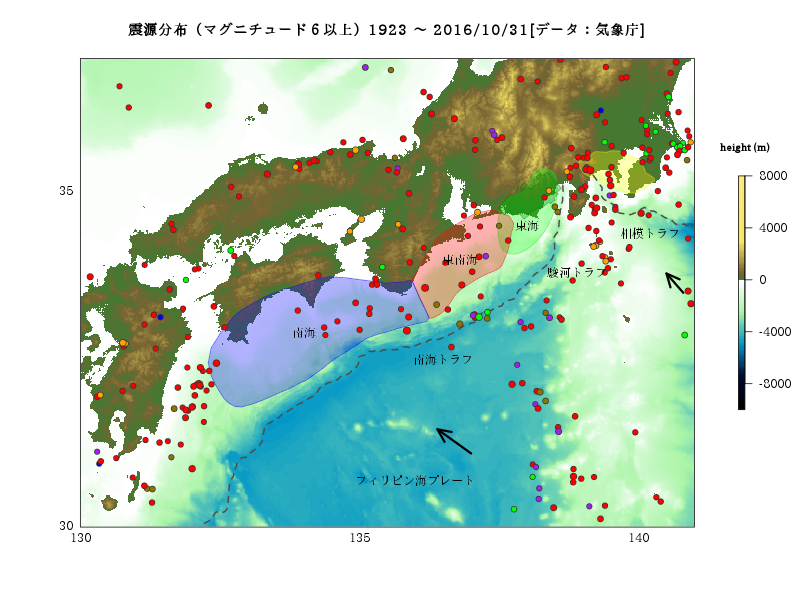load("eq61923_20161031.RData") eqdata<-eq6 eqdata1<-subset(eqdata,depth<10) eqdata1$depth_rank<-" 10km 未満" eqdata1$col<-"red" eqdata2<-subset(eqdata,depth>=10 & depth<20) eqdata2$depth_rank<-" 10km以上20km未満" eqdata2$col<-"orange" eqdata3<-subset(eqdata,depth>=20 & depth<40) eqdata3$depth_rank<-" 20km以上40km未満" eqdata3$col<-"gold4" eqdata4<-subset(eqdata,depth>=40 & depth<80) eqdata4$depth_rank<-" 40km以上80km未満" eqdata4$col<-"green" eqdata5<-subset(eqdata,depth>=80 & depth<150) eqdata5$depth_rank<-" 80km以上150km未満" eqdata5$col<-"blue" eqdata6<-subset(eqdata,depth>=150) eqdata6$depth_rank<-"150km以上" eqdata6$col<-"purple" eq<-rbind(eqdata1,eqdata2,eqdata3,eqdata4,eqdata5,eqdata6) sortlist <- order(eq$mag) eq<- eq[sortlist,] tokai=read.csv("./mapdata/tokai.csv") tonankai=read.csv("./mapdata/tonankai.csv") nankai=read.csv("./mapdata/nankai.csv") kasp=read.csv("./mapdata/kanto_eq.csv") tasp=read.csv("./mapdata/tokai_asperity.csv") trench=read.csv("./mapdata/trench.csv") trough<-data.frame(names=c("駿河トラフ","相模トラフ","南海トラフ","フィリピン海プレート","東海","東南海","南海"), longitude=c(138.9,140.2,136.5,136,138,136.8,134),latitude=c(33.8,34.4,32.5,30.7,34.5,34,32.9)) library(marmap) library(rgdal) library(raster) library("geosphere") Lon.range = c(130, 141) Lat.range = c(30, 37) dat<-getNOAA.bathy(Lon.range[1],Lon.range[2],Lat.range[1],Lat.range[2],res=1,keep=TRUE) r1<-marmap::as.raster(dat) oce<-colorRampPalette(c(rgb(0,0,0),rgb(0,5/255,25/255),rgb(0,10/255,50/255),rgb(0,80/255,125/255),rgb(0,150/255,200/255), rgb(86/255,197/255,184/255),rgb(172/255,245/255,168/255),rgb(211/255,250/255,211/255),rgb(1,1,1))) land1 <- colorRampPalette(c("#467832","#786432")) land2 <- colorRampPalette(c("#786432","#927E3C")) land3 <- colorRampPalette(c("#927E3C","#C6B250")) land4 <- colorRampPalette(c("#C6B250","#FAE664")) land5 <- colorRampPalette(c("#FAE664","#FAEA7E")) breakpoints <- c(seq(-10000,0,10000/100),1 ,seq(50,500,50),seq(550,1000,50),seq(1100,2000,100),seq(2100,3000,100),seq(3500,8000,500)) colors <- c(oce(100),rgb(70/255,120/255,50/255),land1(10),land2(10),land3(10),land4(10),land5(10)) par(family="TakaoExMincho") plot(r1,breaks=breakpoints,col=colors, axis.args=list(at=c(-8000,-4000,0,4000,8000), labels=c(-8000,-4000,0,4000,8000)), legend.args=list(text=" height (m)", side=3, font=2, line=1.5, cex=0.8),las=1,axes=F,box=F) par(xpd=T) axes1<-seq(130,140,5) axes2<-seq(30,35,5) text(axes1,Lat.range[1],as.character(axes1),pos=1) text(Lon.range[1],axes2,as.character(axes2),pos=2) rect(Lon.range[1],Lat.range[1],Lon.range[2],Lat.range[2]) par(xpd=F) title("震源分布(マグニチュード6以上)1923 ~ 2016/10/31[データ:気象庁]") polygon(x=tokai$longitude, y = tokai$latitude, col=rgb(0,1,0,0.3),border=rgb(0,1,0,0.5)) polygon(x=tonankai$longitude, y = tonankai$latitude,col=rgb(1,0,0,0.3),border=rgb(1,0,0,0.5)) polygon(x=nankai$longitude, y = nankai$latitude, col=rgb(0,0,1,0.3),border=rgb(0,0,1,0.5)) polygon(x=kasp$longitude, y = kasp$latitude,col=rgb(1,1,0,0.3),border=rgb(1,1,0,0.5)) polygon(x=tasp$longitude, y = tasp$latitude,col=rgb(0,0.5,0,0.3),border=rgb(0,0.5,0,0.5)) trench1=trench[trench$latitude>=30 & trench$longitude<=141,] lines(x=trench1$longitude, y = trench1$latitude,col="gray30",lty=2,lwd=2) eq1=eq[eq$longitude>=130 & eq$longitude<=141 & eq$latitude>=30 & eq$latitude<=37,] points(x=eq1$longitude, y=eq1$latitude,cex=eq1$mag/6,pch=21,bg=eq1$col,col="gray20") text(x = trough$longitude, y = trough$latitude,labels =trough$names) arrow1<-destPointRhumb(c(140.8,33.5),90-131, 63750/3*2) arrow2<-destPointRhumb(c(137,31.1),90-145, 105000/3*2) arrows(140.8,33.5,arrow1[1],arrow1[2],angle = 25, length = 0.2, code = 2,lwd=3) arrows(137,31.1,arrow2[1],arrow2[2],angle = 25, length = 0.2, code = 2,lwd=3)
| 

